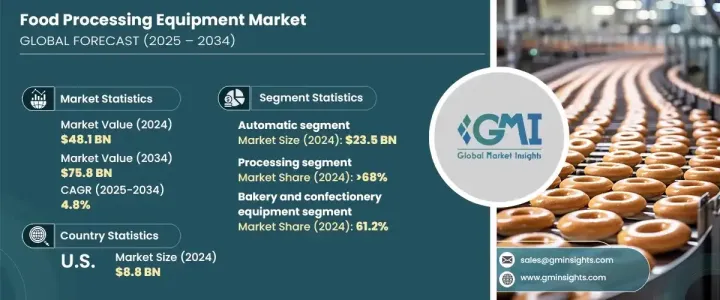
세계의 식품 가공 장비 시장은 2024년에 481억 달러에 이르렀고, 2025년부터 2034년까지 4.8%의 연평균 복합 성장률(CAGR)로 현저한 성장을 이룰 전망입니다.
이 활발한 분야는 소비자 시장을 위해 식품 가공, 조리 및 포장에 사용되는 다양한 장비를 제공함으로써 식품 산업에서 중요한 역할을 수행합니다. 가공 식품 수요가 꾸준히 증가하는 가운데, 시장은 대폭적인 확대를 경험하고 있으며, 식품의 생산 및 유통 방법을 변화시키는 기술의 진보에 의해 더욱 뒷받침되고 있습니다. 자동화는 인공지능(AI) 및 사물인터넷(IoT)과 같은 신흥 기술과 함께 업무의 합리화, 효율 개선, 인건비 절감 등으로 업계에 혁명을 일으키고 있습니다. 자동화가 주역이 됨에 따라, 보다 스마트하고 신뢰할 수 있는 식품 가공 솔루션에 대한 요구가 계속 증가하고 있습니다.

시장은 또한 지속가능성을 중시하는 경향이 강해지고 있으며, 환경기준과 환경에 배려한 관행을 요구하는 소비자 수요를 모두 충족시키기 위해 제조업체가 친환경 장비를 채용하는 경향이 강해지고 있습니다. 이 변화는 생산 시설에서 폐기물과 에너지 소비를 줄이는 데 도움이 되고 시장의 매력을 더욱 높여줍니다. 소비자의 선호도가 지속적으로 진화함에 따라 안전과 품질 기준을 충족시킬 뿐만 아니라 윤리적, 환경적 가치관을 따르는 식품에 대한 관심이 커지고 있습니다. 제조업체는 현재 최종 제품이 소비자의 기대에 확실하게 대응하면서 제품의 품질을 높이고 생산주기를 가속화하며 환경에 미치는 영향을 줄이는 혁신을 우선시하고 있습니다.
| 시장 범위 | |
|---|---|
| 시작 연도 | 2024년 |
| 예측 연도 | 2025-2034년 |
| 시작 금액 | 481억 달러 |
| 예측 금액 | 758억 달러 |
| CAGR | 4.8% |
식품 가공 장비 시장의 자동화 부문은 2024년에 235억 달러에 이르렀으며, 업무 효율 및 수작업 의존도 감소에 대한 수요 증가로 더욱 강력한 성장을 경험하고 있습니다. 이러한 추세는 생산성 향상과 운영 비용 절감을 약속하는 자동화에 대한 업계 전반의 움직임에 힘쓰고 있습니다. 반자동 장치는 또한 완전 자동화 시스템과 수작업의 중간을 제공함으로써 인기를 얻고 있으며, 고비용 자동화에 완전히 커밋하지 않고 효율화를 요구하는 기업에게 매력적인 선택이 되고 있습니다. 반대로 수동 장비의 사용은 점차 감소하고 있으며, 이는 주로 덜 까다로운 생산 요구를 가진 소규모 업무와 관련되어 있기 때문입니다.
2024년에는 베이커리 및 과자류 부문이 식품 가공 장비 시장에서 61.2%의 압도적 점유율을 차지했으며, 이는 구운 과자와 디저트에 대한 소비자 수요 증가에 견인된 것입니다. 마찬가지로 고기, 닭고기, 해산물 가공 기계도 효율을 높이고 제품 품질을 향상시키는 기술 혁신에 힘입어 강력한 성장을 이루고 있습니다. 음료 분야는 또한 음료 가공의 기술적 개선과 다양하고 혁신적인 음료 옵션에 대한 소비자의 욕구가 증가함에 따라 상승 기조에 있습니다.
북미의 식품 가공 장비 시장은 2024년 88억 달러로 평가되었고, 생산성 및 생산 능력을 높이기 위한 자동화 및 보다 스마트한 기술 도입에 중점을 두고 있습니다. 게다가 기업이 지속가능성 목표를 달성하고 에너지 효율적인 제품을 만들려고 노력하고 있기 때문에 환경친화적인 혁신에 대한 강한 뒷받침이 있습니다. 포장 장비 부문은 식품 소비의 편의성을 선호하는 소비자 동향에 맞게 가공 및 포장된 식품 수요에 특히 영향을 받고 있습니다. 이러한 동향이 진화를 계속하고 있는 가운데, 시장은 향후 수년간에 한층 더 확대와 혁신이 전망될 것입니다.
The Global Food Processing Equipment Market reached USD 48.1 billion in 2024 and is set to grow at a remarkable CAGR of 4.8% from 2025 to 2034. This thriving sector plays a vital role in the food industry by providing a diverse array of machinery used to process, prepare, and package food products for consumer markets. With the demand for processed foods rising steadily, the market is experiencing significant expansion, further boosted by technological advancements that are transforming how food is produced and distributed. Automation, coupled with emerging technologies like Artificial Intelligence (AI) and the Internet of Things (IoT), is revolutionizing the industry by streamlining operations, improving efficiency, and reducing labor costs. As automation takes center stage, the need for smarter, more reliable food processing solutions continues to rise.

The market is also witnessing a growing emphasis on sustainability, with manufacturers increasingly adopting eco-friendly equipment to meet both environmental standards and consumer demand for green practices. This shift is helping reduce waste and energy consumption in production facilities, further enhancing the market's appeal. As consumer preferences continue to evolve, there is a rising interest in food products that not only meet safety and quality standards but also align with ethical and environmental values. Manufacturers are now prioritizing innovations that enhance product quality, speed up production cycles, and reduce environmental impact, all while ensuring that the final product meets consumer expectations.
| Market Scope | |
|---|---|
| Start Year | 2024 |
| Forecast Year | 2025-2034 |
| Start Value | $48.1 Billion |
| Forecast Value | $75.8 Billion |
| CAGR | 4.8% |
The automatic segment in the food processing equipment market reached USD 23.5 billion in 2024, experiencing robust growth due to the growing demand for operational efficiency and reduced dependence on manual labor. This trend is fueled by a collective industry move towards automation, which promises improved productivity and reduced operational costs. Semi-automatic equipment also continues to gain popularity as it offers a middle ground between fully automated systems and manual intervention, making it an attractive option for businesses seeking efficiency without fully committing to high-cost automation. Conversely, manual equipment usage is gradually declining, as it remains primarily relevant to smaller operations with less demanding production needs.
In 2024, the bakery and confectionery segment captured a dominant 61.2% share of the food processing equipment market, driven by increasing consumer demand for baked goods and sweets. Similarly, meat, poultry, and seafood processing machinery are witnessing strong growth, supported by innovations that enhance efficiency and elevate product quality. The beverages segment is also on an upward trajectory, driven by technological improvements in beverage processing and the growing consumer appetite for diverse, innovative drink options.
North America food processing equipment market, valued at USD 8.8 billion in 2024, is heavily focused on automation and the adoption of smarter technologies to boost productivity and production capacity. Additionally, there is a strong push toward eco-friendly innovations as companies strive to meet sustainability goals and create energy-efficient products. The packaging equipment segment is particularly impacted by the demand for processed and packaged food items, aligning with consumer trends favoring convenience in food consumption. As these trends continue to evolve, the market is expected to see further expansion and innovation in the coming years.